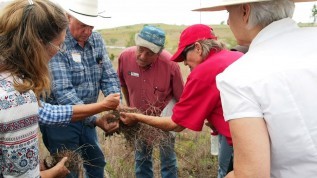HMI Project Manager, Peggy Cole submitted this report on the first workshop in our Mitigating Drought with Holistic Management Workshop Series.
Rain was in the forecast and excitement was in the air as we began the first of a 3-part series of workshops on “Mitigating Drought with Holistic Management” at Bear Creek Ranch near Aledo, TX. This area of Texas has been in extreme drought for years, so no one minded that we changed the agenda to offer all outside activities on day 1 while Day 2 would be mostly indoors.
Reading the land was the topic for the morning sessions. All 4 instructors had a chance to talk about what we would look for in the field to indicate the condition of the rangeland. Walking out into the field the group naturally galvanized around their choice of instructor teams: Richard Teague and Peggy Sechrist or the habitual shovel-toters Betsy Ross and Steve Nelle. Halfway through the session, the participants switched to the other team for a complete view of what all instructors had to share.
The primary message was that the land can tell you a great deal about your stewardship and about her response to climatic conditions. Betsy stressed that “Ma Mature” knows what she is doing. A plant is there sometimes just to heal a condition. Soil type has something to say about condition. Root health will chime in if you dig a little. Plant communities perhaps are the easiest to hear, along with bare ground and litter.
The afternoon was devoted to what to do with this information and the importance of keeping a written and photographic record of your land readings. We divided into 4 small groups and practiced the dart throw method of monitoring where a dart is thrown over the shoulder to assure a random selection for analysis. Various indicators as mentioned above are recorded.
Sure enough the forecast rains came in overnight and left 3 inches in the rain gage by the time we left there Friday afternoon, but not a single participant elected not to come back out in the rain for another day of class. Friday’s agenda took participants far deeper into the understanding of how soil and plant biology work, including the role of roots and grazing, the fungal to bacterial ratios and the vital role of litter. The evaluations at quick glance indicate the vast majority of folks found the content, the pace and the speakers excellent. The understanding was universal that soil can best hold and use water if it has a great diversity of plants with different root configurations and lots of organic matter. How to move the soil in that direction was the favorite take away. Be sure to read about the recap of our second workshop in this series.And our third recap.



